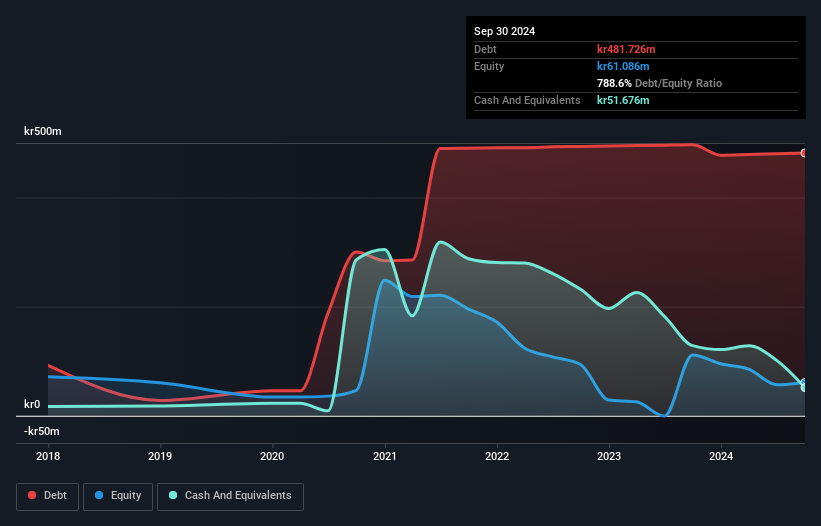
David Iben put it well when he said, 'Volatility is not a risk we care about. What we care about is avoiding the permanent loss of capital.' So it seems the smart money knows that debt - which is usually involved in bankruptcies - is a very important factor, when you assess how risky a company is. We can see that Omda AS (OB:OMDA) does use debt in its business. But is this debt a concern to shareholders?
When Is Debt A Problem?
Generally speaking, debt only becomes a real problem when a company can't easily pay it off, either by raising capital or with its own cash flow. Ultimately, if the company can't fulfill its legal obligations to repay debt, shareholders could walk away with nothing. However, a more usual (but still expensive) situation is where a company must dilute shareholders at a cheap share price simply to get debt under control. Of course, the upside of debt is that it often represents cheap capital, especially when it replaces dilution in a company with the ability to reinvest at high rates of return. The first step when considering a company's debt levels is to consider its cash and debt together.
See our latest analysis for Omda
What Is Omda's Debt?
The chart below, which you can click on for greater detail, shows that Omda had kr481.7m in debt in September 2024; about the same as the year before. On the flip side, it has kr51.7m in cash leading to net debt of about kr430.1m.

A Look At Omda's Liabilities
We can see from the most recent balance sheet that Omda had liabilities of kr122.9m falling due within a year, and liabilities of kr509.9m due beyond that. Offsetting these obligations, it had cash of kr51.7m as well as receivables valued at kr89.1m due within 12 months. So it has liabilities totalling kr492.1m more than its cash and near-term receivables, combined.
This deficit is considerable relative to its market capitalization of kr799.1m, so it does suggest shareholders should keep an eye on Omda's use of debt. Should its lenders demand that it shore up the balance sheet, shareholders would likely face severe dilution.
We measure a company's debt load relative to its earnings power by looking at its net debt divided by its earnings before interest, tax, depreciation, and amortization (EBITDA) and by calculating how easily its earnings before interest and tax (EBIT) cover its interest expense (interest cover). Thus we consider debt relative to earnings both with and without depreciation and amortization expenses.
Weak interest cover of 0.17 times and a disturbingly high net debt to EBITDA ratio of 6.5 hit our confidence in Omda like a one-two punch to the gut. The debt burden here is substantial. One redeeming factor for Omda is that it turned last year's EBIT loss into a gain of kr9.9m, over the last twelve months. There's no doubt that we learn most about debt from the balance sheet. But it is future earnings, more than anything, that will determine Omda's ability to maintain a healthy balance sheet going forward. So if you want to see what the professionals think, you might find this free report on analyst profit forecasts to be interesting.
Finally, a company can only pay off debt with cold hard cash, not accounting profits. So it's worth checking how much of the earnings before interest and tax (EBIT) is backed by free cash flow. During the last year, Omda produced sturdy free cash flow equating to 70% of its EBIT, about what we'd expect. This free cash flow puts the company in a good position to pay down debt, when appropriate.
Our View
While Omda's net debt to EBITDA makes us cautious about it, its track record of covering its interest expense with its EBIT is no better. But at least its conversion of EBIT to free cash flow is a gleaming silver lining to those clouds. We should also note that Healthcare Services industry companies like Omda commonly do use debt without problems. When we consider all the factors discussed, it seems to us that Omda is taking some risks with its use of debt. While that debt can boost returns, we think the company has enough leverage now. There's no doubt that we learn most about debt from the balance sheet. However, not all investment risk resides within the balance sheet - far from it. For example - Omda has 2 warning signs we think you should be aware of.
If, after all that, you're more interested in a fast growing company with a rock-solid balance sheet, then check out our list of net cash growth stocks without delay.
New: AI Stock Screener & Alerts
Our new AI Stock Screener scans the market every day to uncover opportunities.
• Dividend Powerhouses (3%+ Yield)
• Undervalued Small Caps with Insider Buying
• High growth Tech and AI Companies
Or build your own from over 50 metrics.
Have feedback on this article? Concerned about the content? Get in touch with us directly. Alternatively, email editorial-team (at) simplywallst.com.
This article by Simply Wall St is general in nature. We provide commentary based on historical data and analyst forecasts only using an unbiased methodology and our articles are not intended to be financial advice. It does not constitute a recommendation to buy or sell any stock, and does not take account of your objectives, or your financial situation. We aim to bring you long-term focused analysis driven by fundamental data. Note that our analysis may not factor in the latest price-sensitive company announcements or qualitative material. Simply Wall St has no position in any stocks mentioned.
About OB:OMDA
Omda
Provides software solutions for healthcare sector in Norway, Sweden, Denmark, Finland, and internationally.
Reasonable growth potential and fair value.
Market Insights
Community Narratives



